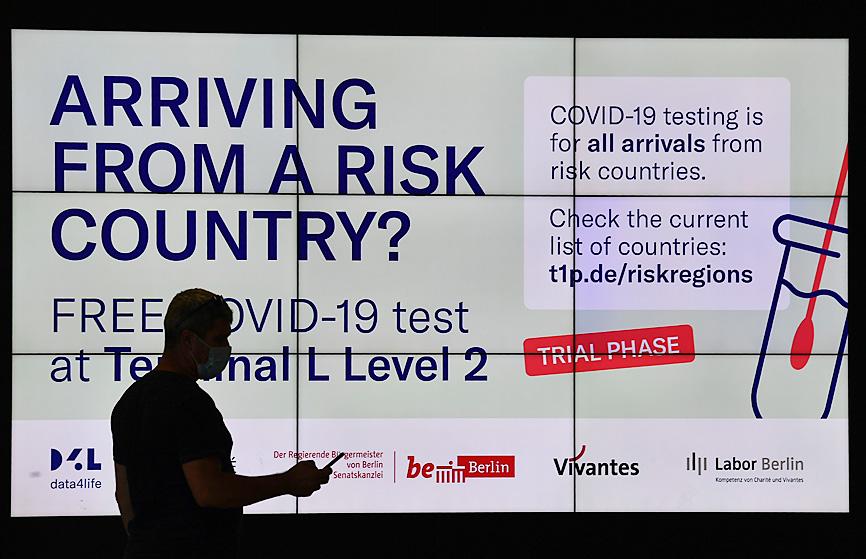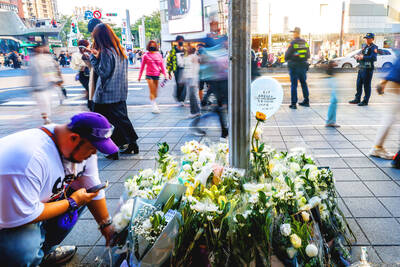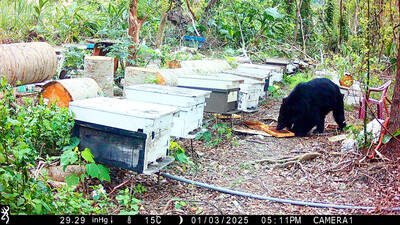Public health experts and medical specialists yesterday debated whether conducting mass testing for COVID-19 on all travelers arriving in Taiwan is needed to bolster prevention efforts against SARS-CoV-2, and there seemed to be some agreement that it was not needed for the general public at this time.
The topic has become subject of heated public debate after an asymptomatic teenager under quarantine in Changhua County tested positive for COVID-19, highlighting the practice of the Changhua County Public Health Bureau to test the hundreds of people in the county under 14-day home quarantine after returning to Taiwan even if they had no COVID-19 symptoms.
The move appears to contravene the Central Epidemic Command Center’s (CECC) quarantine policy, which does not allow people under quarantine to leave the place they are isolating, and for people to be tested only if they report symptoms.

Photo: AFP
The CECC last week ordered an investigation into why and how the Changhua bureau has been running its testing program.
A conference was held in Taipei yesterday by the Taiwan Society of Microbiology, the Taiwan Society of Clinical Pathologists and the Society of Taiwan Long-Term Care Infection Prevention and Control, to discuss the pros and cons of mass testing.
The highly contagious nature of SARS-CoV-2 has been shown by the fact that more than 23 million people have been infected and more than 800,000 people have died, said Centers for Disease Control (CDC) Deputy Director-General Chuang Jen-hsiang (莊人祥), who also serves as the CECC’s spokesman.
Having rapid and accurate testing is a key factor in containing the virus, so the CDC developed COVID-19 polymerase chain reaction (PCR) test methods early on in the outbreak, and Taiwan’s testing capacity has been expanded to more than 65 healthcare facilities nationwide and more than 7,400 tests per day, he said.
The testing numbers would continue to grow, he said.
Tony Chen (陳秀熙), vice dean of National Taiwan University’s (NTU) College of Public Health, said an important point of testing is detecting asymptomatic carriers, but he is not in favor of conducting “mass testing” on the general public, but only on travelers arriving from high-risk countries.
Conducting continuous COVID-19 antibody testing could be an effective method of understanding the past infections, as it would allow the government to understand local infections and community spread, the nation’s herd immunity, and to detect asymptomatic carriers, Chen said.
Such a program would also help in the development of vaccines, he said.
Several nations, including Singapore, the US, the UK, Spain and Iceland, have been conducting antibody testing and surveillance, which can help them understand the neutralizing antibody response in patients with mild symptoms and those with serious complications, and accelerate vaccine development, he added.
There is an urgent need for COVID-19 antibody testing, as no one yet knows how long antibody immunity can last, he said.
Lee Ping-ing (李秉穎), a physician at NTU Hospital’s division of pediatric infectious disease and a member of the CECC’s expert advisory panel, said mass testing could include testing all travelers arriving in Taiwan, and PRC testing and antibody testing on the general public.
However, it was important to remember that while many people cite Iceland as an example of a nation with a mass testing policy, only about 10 percent of its population has been tested for COVID-19, and as it loosened its border control policies after expanding its testing program, the number of local infections began to increase, Lee said.
For Taiwan, the cost of conducting mass PCR testing is too high, while its benefit might be close to none, given that there have been no reports of local infections for a long time, he said.
Another factor is that mass testing on the general public could result in many false-positive returns, which could cause public panic, he said.

SHIPS, TRAINS AND AUTOMOBILES: The ministry has announced changes to varied transportation industries taking effect soon, with a number of effects for passengers Beginning next month, the post office is canceling signature upon delivery and written inquiry services for international registered small packets in accordance with the new policy of the Universal Postal Union, the Ministry of Transportation and Communications said yesterday. The new policy does not apply to packets that are to be delivered to China, the ministry said. Senders of international registered small packets would receive a NT$10 rebate on postage if the packets are sent from Jan. 1 to March 31, it added. The ministry said that three other policies are also scheduled to take effect next month. International cruise ship operators

HORROR STORIES: One victim recounted not realizing they had been stabbed and seeing people bleeding, while another recalled breaking down in tears after fleeing A man on Friday died after he tried to fight the knife-wielding suspect who went on a stabbing spree near two of Taipei’s busiest metro stations, Taipei Mayor Chiang Wan-an (蔣萬安) said. The 57-year-old man, identified by his family name, Yu (余), encountered the suspect at Exit M7 of Taipei Main Station and immediately tried to stop him, but was fatally wounded and later died, Chiang said, calling the incident “heartbreaking.” Yu’s family would receive at least NT$5 million (US$158,584) in compensation through the Taipei Rapid Transit Corp’s (TRTC) insurance coverage, he said after convening an emergency security response meeting yesterday morning. National

PLANNED: The suspect visited the crime scene before the killings, seeking information on how to access the roof, and had extensively researched a 2014 stabbing incident The suspect in a stabbing attack that killed three people and injured 11 in Taipei on Friday had planned the assault and set fires at other locations earlier in the day, law enforcement officials said yesterday. National Police Agency (NPA) Director-General Chang Jung-hsin (張榮興) said the suspect, a 27-year-old man named Chang Wen (張文), began the attacks at 3:40pm, first setting off smoke bombs on a road, damaging cars and motorbikes. Earlier, Chang Wen set fire to a rental room where he was staying on Gongyuan Road in Zhongzheng District (中正), Chang Jung-hsin said. The suspect later threw smoke grenades near two exits

The Forestry and Nature Conservation Agency yesterday launched a gift box to market honey “certified by a Formosan black bear” in appreciation of a beekeeper’s amicable interaction with a honey-thieving bear. Beekeeper Chih Ming-chen (池明鎮) in January inspected his bee farm in Hualien County’s Jhuosi Township (卓溪) and found that more than 20 beehives had been destroyed and many hives were eaten, with bear droppings and paw prints near the destroyed hives, the agency said. Chih returned to the farm to move the remaining beehives away that evening when he encountered a Formosan black bear only 20m away, the agency said. The bear